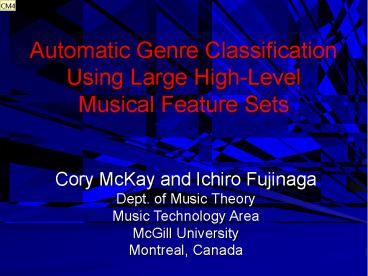Automatic Genre Classification Using Large HighLevel Musical Feature Sets - PowerPoint PPT Presentation
Title:
Automatic Genre Classification Using Large HighLevel Musical Feature Sets
Description:
Jazz. Bebop. Jazz Soul. Swing. Popular. Rap. Punk. Country. Western Classical. Baroque. Modern Classical ... e.g. whether modern instruments are present ... – PowerPoint PPT presentation
Number of Views:170
Avg rating:3.0/5.0
Title: Automatic Genre Classification Using Large HighLevel Musical Feature Sets
1
Automatic Genre Classification Using Large
High-Level Musical Feature Sets
- Cory McKay and Ichiro Fujinaga
- Dept. of Music Theory
- Music Technology Area
- McGill University
- Montreal, Canada
2
Topics
- Introduction
- Existing research
- Taxonomy
- Features
- Classification methodology
- Results
- Conclusions
3
Introduction
- GOAL Automatically classify symbolic recordings
into pre-defined genre taxonomies - This is first stage of a larger project
- General music classification system
- Classifies audio
- Simple interface
4
Why symbolic recordings?
- Valuable high-level features can be used which
cannot currently be extracted from audio
recordings - Research provides groundwork that can immediately
be taken advantage of as transcription techniques
improve - Can classify music for which only scores exist
(using OMR) - Can aid musicological and psychological research
into how humans deal with the notion of musical
genre - Chose MIDI because of diverse recordings
available - Can convert to MusicXML, Humdrum, GUIDO, etc.
relatively easily
5
Existing research
- Automatic audio genre classification becoming a
well researched field - Pioneering work Tzanetakis, Essl Cook
- Audio results
- Less than 10 categories
- Success rates generally below 80 for more than 5
categories - Less research done with symbolic recordings
- 84 for 2-way classifications (Shan Kuo)
- 63 for 3-way classifications (Chai Vercoe)
- Relatively little applied musicological work on
general feature extraction. Two standouts - Lomax 1968 (ethnomusicology)
- Tagg 1982 (popular musicology)
6
Taxonomies used
- Used hierarchical taxonomy
- A recording can belong to more than one category
- A category can be a child of multiple parents in
the taxonomical hierarchy - Chose two taxonomies
- Small (9 leaf categories)
- Used to loosely compare system to existing
research - Large (38 leaf categories)
- Used to test system under realistic conditions
7
Small taxonomy
- Jazz
- Bebop
- Jazz Soul
- Swing
- Popular
- Rap
- Punk
- Country
- Western Classical
- Baroque
- Modern Classical
- Romantic
8
Large taxonomy
9
Training and test data
- 950 MIDI files
- 5 fold cross-validation
- 80 training, 20 testing
10
Features
- 111 high-level features implemented
- Instrumentation
- e.g. whether modern instruments are present
- Musical Texture
- e.g. standard deviation of the average melodic
leap of different lines - Rhythm
- e.g. standard deviation of note durations
- Dynamics
- e.g. average note to note change in loudness
- Pitch Statistics
- e.g. fraction of notes in the bass register
- Melody
- e.g. fraction of melodic intervals comprising a
tritone - Chords
- e.g. prevalence of most common vertical interval
- More information available in Cory McKays
masters thesis (2004)
11
Overview of the classifier
12
A classifier ensemble
13
Feature types
- One-dimensional features
- Consist of a single number that represents an
aspect of a recording in isolation - e.g. an average or a standard deviation
- Multi-dimensional features
- Consist of vectors of closely coupled statistics
- Individual values may have limited significance
taken alone, but together may reveal meaningful
patterns - e.g. bins of a histogram, instruments present
14
Classifiers used
- K-nearest neighbour (KNN)
- Fast
- One for all one-dimensional features
- Feedforward neural networks
- Can learn complex interrelationships between
features - One for each multi-dimensional feature
15
Simplified classifier ensemble
16
A classifier ensemble
- Consists of one KNN classifier and multiple
neural nets - An ensemble with n candidate categories
classifies a recording into 0 to n categories - Input
- All available feature values
- Output
- A score for each candidate category based on a
weighted average of KNN and neural net output
scores
17
Simplified classifier ensemble
18
Complete classifier ensemble
19
Feature and classifier selection/weighting
- Some features more useful than others
- Context dependant
- e.g. best features for distinguishing between
Baroque and Romantic different than when
comparing Punk and Heavy Metal - Hierarchical and round-robin classifiers only
trained on recordings belonging to candidate
categories - Feature selection allows specialization to
improve performance - Used genetic algorithms to perform
- Feature selection (fast) followed by
- Feature weighting of survivors
20
Complete classifier ensemble
21
Complete classifier
22
Exploration of taxonomy space
- Three kinds of classification performed
- Parent (hierarchical)
- 1 ensemble for each category with children
- Only promising branch(es) of taxonomy explored
- Field initially narrowed using relatively easy
broad classifications before proceeding to more
difficult specialized classifications - Flat
- 1 ensemble classifying amongst all leaf
categories - Round-robin
- 1 ensemble for each pair of leaf categories
- Final results arrived at through averaging
23
Complete classifier
24
Overall average success rates across all folds
- 9 Category Taxonomy
- Leaf 86
- Root 96
- 38 Category Taxonomy
- Leaf 57
- Root 75
25
Importance of number of candidate features
- Examined effect on success rate of only providing
subsets of available features to feature
selection system
26
Conclusions
- Success rates better than previous research with
symbolic recordings and on the upper end of
research involving audio recordings - True comparisons impossible to make without
standardized testing - Effectiveness of high-level features clearly
demonstrated - Large feature library combined with feature
selection improves results - Not yet at a point where can effectively deal
with large realistic taxonomies, but are
approaching that point
27
(No Transcript)































